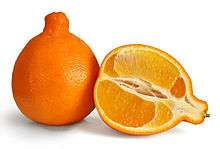Tangelo
| Tangelo | |
|---|---|
 | |
| A tangelo fruit (Cushman Honeybells) | |
| Scientific classification | |
| Kingdom: | Plantae |
| (unranked): | Angiosperms |
| (unranked): | Eudicots |
| (unranked): | Rosids |
| Order: | Sapindales |
| Family: | Rutaceae |
| Genus: | Citrus |
| Species: | C. × tangelo |
| Binomial name | |
| Citrus × tangelo J.W. Ingram & H.E. Moore, 1975 | |
The tangelo (/ˈtændʒəloʊ/ TAN-jə-loh, /tænˈdʒɛloʊ/ tan-JEL-oh; C. reticulata × C. maxima or x C. paradisi), Citrus × tangelo, is a citrus fruit hybrid of a tangerine and a grapefruit.
Sometimes referred to as honeybells, they are the size of an adult fist, have a tart, tangy, tangerine taste, and are juicy at the expense of flesh. They generally have loose skin and are easier to peel than oranges,[1] readily distinguished from them by a characteristic "nipple" at the stem. Tangelos can be used as a substitute for mandarin oranges or sweet oranges.
Varieties of tangelos
Orlando
The early maturing Orlando tangelo is noted for its rich juiciness, mild and sweet flavour, large size, distinct zesty smell, and flat-round shape with a characteristic knob. California/Arizona tangelos have a slightly pebbled texture, vibrant interior and exterior colour, very few seeds, and a tight-fitting rind. Orlando tangelos are available from mid-November to the beginning of February. The tangelo originated as a cross between a Duncan grapefruit and a Dancy tangerine.[2] W. T. Swingle of the United States Department of Agriculture (USDA) is credited with creating the hybrid in 1911. When the Orlando tangelo was first cultivated, it was known by the name Lake tangelo. The trees of this variety grow to a large size and are easily recognised by their cup-shape leaves. Orlando tangelos are recognised as one of the more cold-tolerant varieties. Northern Florida grows significantly fewer tangelos, but they are much sweeter due to climate.
Minneola
The Minneola tangelo (sometimes misspelled "Mineola" or "Myneeowleh") is a cross between a Duncan grapefruit and a Dancy tangerine, and was released in 1931 by the USDA Horticultural Research Station in Orlando. It is named after Minneola, Florida. Most Minneola tangelos are characterised by a stem-end neck, which tends to make the fruit appear bell-shaped. Because of this, it is also called the Honeybell in the gift fruit trade, where it is one of the most popular varieties. A true Honeybell Tangelo is a hybrid-cross between Thompson tangerine and a pomelo, hence the name Tangelo released by the USDA. Both Minneolas and Honeybells are usually fairly large, typically 3–3½ inches in diameter; the Honeybells tend to be larger and sweeter. The peel colour, when mature, is a bright-reddish-orange colour. The rind of the Minneola is relatively thin, while the rind of the Honeybell is slightly thicker. Both the Minneola and Honeybell Tangelo peel rather easily. Both are very juicy. Both the Minneola and the Honeybell are not strongly self-fruitful, and yields will be greater when interplanted with suitable pollenisers such as Temple tangor, Sunburst tangerine, or possibly Fallglo tangerine. It tends to bear a good crop every other year.[3] In the Northern Hemisphere the fruit matures in the December–February period, with January being the peak.
Drug interactions
One study thus far has shown that, unlike grapefruit, interactions with statins are not likely with tangelos. Although the tangelo is derived from a grapefruit crossed with a tangerine, the furocoumarins in grapefruit are not expressed in tangelos.[4]
References in Popular Culture
In an episode of Wings titled "The Person Formerly Known as Lowell", which originally aired on October 31, 1995, Joe Hackett (Tim Daly) is disgusted when he finds out that Casey (Amy Yasbeck) found his Tangelo in the refrigerator and threw it in the garbage. he then angrily asks her, "Who told you you could touch my Tangelo??" Helen (Crystal Bernard) then refers to it as "that creepy fruit Joe eats".
Notes
- ↑ Meadow, Jean; King, Mary. "Florida Food Fare – Tangelo" (PDF). Institute of Food and Agricultural Sciences, University of Florida. Archived from the original (PDF) on 2017-08-20. Retrieved 2018-02-02.
- ↑ Jackson, Larry K.; Futch, Stephen H. "Orlando Tangelo". Institute of Food and Agricultural Sciences, University of Florida. Retrieved February 4, 2014.
- ↑ Jackson, Larry K.; Futch, Stephen H. "Minneola Tangelo". Institute of Food and Agricultural Sciences, University of Florida. Retrieved June 21, 2013.
- ↑ Widmer, Wilbur (May 4, 2005). "One tangerine/grapefruit hybrid (tangelos) contains trace amounts of furanocoumarins at a level too low to be associated with grapefruit/drug interactions". Journal of Food Science. 70 (6): C419–C422. doi:10.1111/j.1365-2621.2005.tb11440.x.
References
- Morton, Julia F. (1987). Fruits of Warm Climates: Tangelo. pp. 158–160. ISBN 9780961018412.
- Jackson, Larry K. and Futch, Stephen H., Fact Sheet HS-171 Retrieved March 28, 2005.
- Krezdorn, A.H. 1981. "Fruit Set of Citrus." Proc. Int. Soc. Citriculture. 1981:249–253.
- Krezdorn, A.H. 1977. "Influence of Rootstock on Mandarin Cultivars." Proc. Int. Soc. Citriculture. Vol. 2. pp. 513–518.
- Krezdorn, A.H. and W.J. Wiltbank. 1968. "Annual Girdling of 'Orlando' Tangelos over an Eight-Year Period." Proc. Fla. State Hort. Soc. Vol. 81:29–35.
- Saunt, James. 2000. Citrus Varieties of the World. Sinclair International Limited, Norwich, England. p. 82.
- Tucker, D.P.H., S.H. Futch, F.G. Gmitter, and M.C. Kesinger. Florida Citrus Varieties. 1998. SP-102. University of Florida. p. 31.
- Tucker, D.P.H., A.K. Alva, L.K. Jackson, and T.A. Wheaton. 1995. Nutrition of Florida Citrus Trees. SP-169. University of Florida, Institute of Food and Agricultural Sciences, Cooperative Extension Service. p. 27.
- Whiteside, J. O. 1979. "Alternaria Brown Spot of Dancy Tangerine and its Control." Proc. Fla. State Hort. Soc. 92:34–37.
External links
- Baboons discover new citrus fruit in W.Cape (12 January 2011)
| Wikimedia Commons has media related to Citrus Tangelo group. |
| Wikispecies has information related to Citrus tangelo |